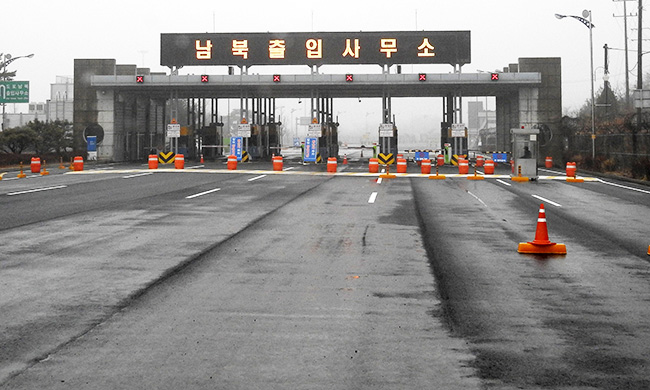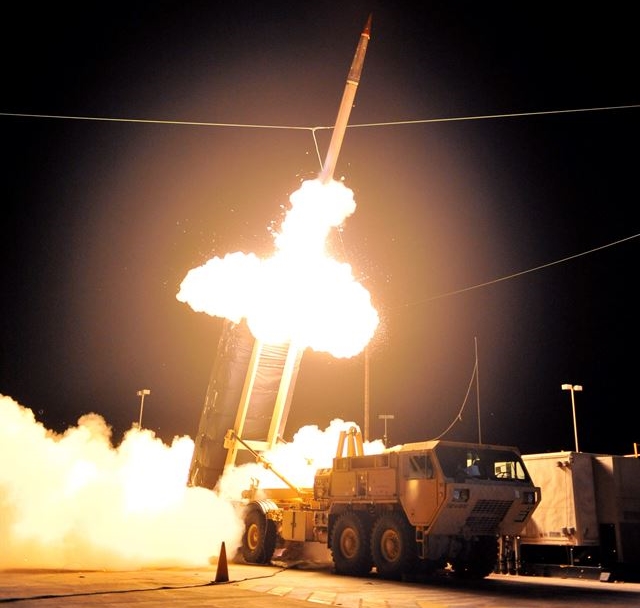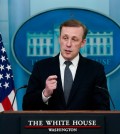- California Assembly OKs highest minimum wage in nation
- S. Korea unveils first graphic cigarette warnings
- US joins with South Korea, Japan in bid to deter North Korea
- LPGA golfer Chun In-gee finally back in action
- S. Korea won’t be top seed in final World Cup qualification round
- US men’s soccer misses 2nd straight Olympics
- US back on track in qualifying with 4-0 win over Guatemala
- High-intensity workout injuries spawn cottage industry
- CDC expands range of Zika mosquitoes into parts of Northeast
- Who knew? ‘The Walking Dead’ is helping families connect
USFK to deploy THAAD

The road to the Kaeseong Industrial Complex in North Korea is empty, Friday. All South Korean workers left the industrial park safely Thursday after North Korea closed the area and froze all South Korean assets there. (Yonhap)
By Rachel Lee
South Korea will allow the United States to deploy at least one terminal high altitude area defense (THAAD) battery for defense against North Korean missiles, a senior military official said Friday.
A Korea-U.S. joint working group for the deployment of THAAD will hold its first meeting next week. Topics will include possible candidate sites to host the battery, how to share operational costs and the exact schedule for deployment, the official said.
“South Korea and the U.S. are in the final stages of talks on how to operate the joint working group,” the official told reporters on condition of anonymity. “The team should be able to discuss the deployment as early as next week.”
Apart from bases of the United States Forces Korea, the team will come up with other possible locations for the battery that will “maximize military efficacy while ensuring the safety of residents,” said the official.
He said that any relations with neighboring countries — including China — will not be considered in the decision-making process.
“South Korea will take charge of the site and other infrastructure, while the U.S. will bear the cost of deployment and operation,” the official said.
A THAAD battery consists of six launcher vehicles, each equipped with eight missiles, with two mobile tactical operations centers and a ground based radar.
Next week’s talks are expected to increase tensions in Northeast Asia with China and Russia consistently showing strong opposition to THAAD deployment on South Korean soil.
China, the North’s key ally, has shown more concern over the deployment than it has over Pyongyang’s rocket launch.
Chinese Foreign Minister Wang Yi expressed “serious concern” over South Korea’s move to allow the U.S. missile defense system to be deployed, Friday.
Wang conveyed the concern to Korean Foreign Minister Yun Byung-se during their meeting in Munich on the sidelines of international talks on Syria.
Russia’s Ministry of Foreign Affairs also said in a statement Wednesday that THAAD deployment in a region with a “highly intricate security situation” could “trigger an arms race in Northeast Asia and complicate a resolution to the Korean Peninsula nuclear issue.”
“This once again proves the correctness of our stance that the creation of a comprehensive system of peace in Northeast Asia that would heed the security interests of all regional states is a mandatory pre-condition for settling the situation on the Korean Peninsula,” the ministry said.
Official discussions are about to kick off, but experts here have cast doubt over the effectiveness of the system.
The U.S. claims the system has a 90 percent accuracy rate, but military authorities have not raised questions about it nor tested it to see if the system will work properly under the geographical situation on the peninsula.
Military officials believe that THAAD can shoot down North Korean missiles with a range of 300 to 500 kilometers.
“The military authorities are providing sites and infrastructure for a weapon without examining unproven claims,” said Kim Dong-yeop, a research professor at the Kyungnam University Institute for Far Eastern Studies. “It will not bring any benefit to our country in the long-term.”

















Pingback: How To Beat Ap Yi Aram | karmahowto.com